by Carol A Westbrook

Chocolate. The very word makes your mouth water; it conjures up images of childhood, of ice cream sundaes, of Valentine’s Day, of love. A small piece in your mouth makes you happy and improves your outlook—and makes you want more. chocolate is a stimulant, a mood elevator. And so many people reached for a piece of chocolate to help get through the dark days of the Covid-19 pandemic, as reflected in the increased chocolate sales during those months
Can chocolate really do all of these things? A surprising amount of research has been done to try to answer this question, with inconclusive results. Yes, there are pharmacoactive substances in chocolate, the most prominent of which is theobromine. This chemical which is named for the plant in which it was discovered, the cacao tree, (Theobroma cacao), the source of chocolate. Carl Linnaeus, the great Swedish botanist, gave the plant its name, perhaps in recognition of its importance to the natives that cultivated it. Theobroma contains the Greek words theo (god) and broma (food), meaning food of the gods—there is no bromine in the substance. Theobromine is a mild stimulant, similar to caffeine. It is also present in green tea and Yerba mate. A milk chocolate bar contains about 60 milligrams of theobromine, while dark chocolate has about 3 times as much. Consumption of an entire dark chocolate bar can have some pleasant mood effects, while three dark chocolate bars can cause sweating, trembling, and headaches. But keep your chocolate bars away from your dogs, because theobromine cannot be metabolized by animals, and it is toxic to them.
Cocoa also contains some caffeine, and small amounts of other compounds including cannabinoids, analogs of the active substance in cannabis, or marijuana—although these cannabinoids won’t get you high. There are other active compounds in cacao, but in too small amounts to have any effects. So the long and the short of it is that chocolate is a mild stimulant, and does not have any magical or aphrodisiac effects. On the other hand, consuming chocolate gives so many people pleasure, comfort, and gratification, which is very hard to quantitate in a scientific study, though many have tried. And the lore of chocolate persists and colors our opinions of this wonderful food.
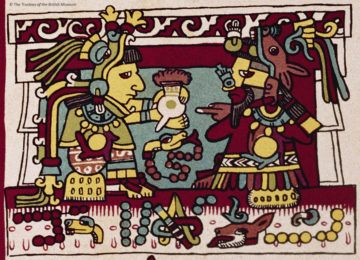
Chocolate has come a long way from the bloodthirsty Aztec ceremonies to the chocolate bars we consume today. The story of chocolate begins about several millennia ago. Deep in the rainforests of the Yucatan, in the shadow of the great pyramids, the Mayans discovered a tasty bean which seemed to have magical powers of stimulation and restoration. They called this bean Xocoatl. The Mayans collected the pods, roasted them, removed the seeds and ground these seeds into a paste that was used to make an invigorating drink. The Mayan people cultivated these beans, both for their own use and for trading throughout Mesoamerica. Cacao beans were so valuable that they were used a money. The Aztecs were especially fond of Xocoatl, which was used as a stimulant for their bloodthirsty warriors, and in their religious ceremonies. My guess is that it had the mood-altering effects equivalent to 1-2 dark chocolate bars, as discussed above. The Aztecs regarded Xocoatl as gift from the gods.
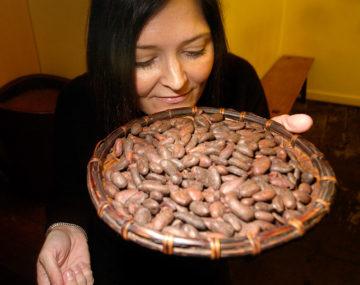
Legend has it that the ruler of the Aztecs, Montezuma, introduced cacao to the Spanish conquistador Hernan Cortes in the 1540’s. Cortes probably tasted chocolate in the form of this chilled, bitter, spicy drink. The drink was made from ground cacao beans stewed with hot peppers and vanilla, and then served chilled. The Europeans were not accustomed to this frothy drink with a strangely appealing flavor, but recognized its restorative powers. Cortes recognized the value of these cacao beans, and continued to drink it during his 8 years of exploration. He was likely the one who introduced it to Europeans as a potential valuable commodity for trade.
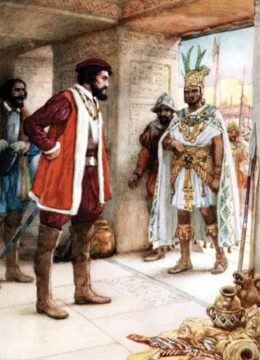
In 1544 Dominican Friars introduced Prince Philip of Spain to this bitter drink flavored with unfamiliar New World spices. To make the drink more appealing, it was sweetened with honey and more familiar spices such as cinnamon and nutmeg. It became a royal favorite, a luxury for the very wealthy. At that time there were very few social drinks that were stimulants; coffee and tea were two, and chocolate was another. Most people were not barraged with a lot of caffeinated and stimulant beverages, as we are today, so the effect of theobromine was dramatic.
This New World product fetched a high price, and a lucrative trade developed, initially by the Spanish who controlled the land where cacao trees grew. Theobroma (cacao) trees are small, delicate trees that grow in hot humid climates only if protected from direct sunlight. They thrive in a narrow belt within 10° north or south of the equator. These were Mayan land, and the Mayan people cultivated this valuable crop using slash and burn techniques to clear rainforest.
The preparation of cacao powder was very labor-intensive: the pods ripen at different times and must be hand-picked. Each pod contains 20 – 50 beans, which are dried and traded in bulk. As the Spanish explored and settled the Americas, they established plantations of New World crops, tended by native and imported slaves. Cacao became a trade stable, a precious, expensive commodity.
It took the Dutch to firmly establish the chocolate trade, when they took control of Curaçao in the early 1600’s. This island had an excellent climate for cacao plantations. The Dutch traders important the beans to Holland, where they were processed into a powder that was used primarily for the cacao drink. Amsterdam became the chief port for the chocolate trade. Unlike coffee, which was also consumed as a drink, chocolate was a luxury only the wealthy could afford. In 1615, for example, it was served at the wedding of French King Louis XIII to Anne of Austria, daughter of Spanish King Phillip III. Anne was a chocolate enthusiast, and she introduced this alluring drink to the courtiers. The French considered chocolate an aphrodisiac. Soon chocolate houses were established throughout Europe.
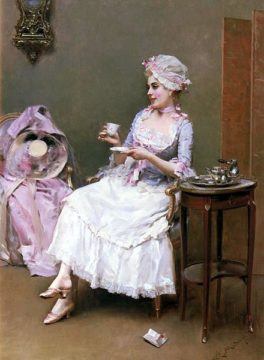
By the 18th century, Dutch merchants controlled virtually the entire trade in cocoa, stimulating a local cocoa industry in Amsterdam. It was the Dutch who turned chocolate into the modern product with which we are all familiar with today. In 1828, Casparus van Houten Sr. developed and patented an inexpensive method for processing cacao, which was the paste obtained from ground, roasted cacao beans. Van Houten invented a press which extracted the fat, (known as cocoa butter. The remaining solids were pulverized into cocoa powder, the basis of all chocolate products. Van Houten’s son, also Casparus, further improved on cocoa powder by treating it with alkali to neutralize its acidity. The alkali darkened the color and made the powder more soluble. This “Dutch process” chocolate was easier to use for chocolate drinks, and could also be re-mixed with cocoa butter to create a product similar to today’s eating chocolate. The Swiss inventor Daniel Peter further refined the product, by adding condensed milk and cocoa butter to the powder, to create the milk chocolate bar. Swiss chocolate is among the finest in the world.
As the Dutch colonial empire began to decline, other countries took over the trade, and eventually it was dominated by the large multi-national chocolate companies –Mars, Mondelez, Nestle, Ferrero Group and Hershey. But the trade continues pretty much the way it did in the 1800’s, with large trading companies purchasing beans from small farms, and processing them in their own factories. Today, most of the worlds’ chocolate is grown in several countries that can support the strict environmental constraints of the Theobroma plant: West Africa produces 70% of the world’s cocoa, with Cote d’Ivoire alone responsible for 30%. Ghana, Indonesia, Brazil, Cameroon, Ecuador and Peru grow must of the rest, with some contribution from other equatorial countries. There are three main cultivars of Theobroma: Criollo, which is the original variety grown by the Mayans, representing 10% of the world’s production. It is used in the finest chocolates. Forastero is a cultivar that makes up 80% of world production; it is hardy and resistant, but the taste is not as good as others. This is the main chocolate used in Hershey and other lower-end candies. Other varieties are grown in smaller amounts, such as Arriba, with its orange blossom fragrance and an excellent flavor. Although you can find chocolate bars made out of chocolate from a single geographic labelled as “single origin chocolate,” they rarely indicate the type of chocolate they contain.
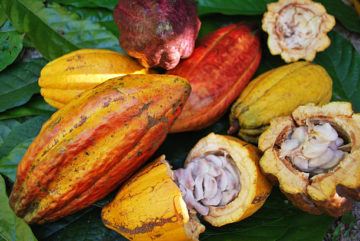
Cacao is an important export crop, especially to many small countries that depend on it as a major source of revenues. To help protect this crop, the British government has established the International Cocoa Quarantine Centre, CQC, located in a Arborfield, UK. As new varieties of cacao are discovered in tropical rainforests, they are sent to the Centre, where they are established and checked for pests and diseases and then put through a rigorous quarantine process which takes about two years. After this, they are moved to a separate facility where they are sent to researchers or even to growers. This process helps to identify new plants with disease resistance and other desirable traits, while it also prevents the spread of diseased crops. This helps maintain new species with valuable traits while existing cacao crops, because this finicky plant is unusually susceptible to diseases. For example, in the 1980’s, Brazil was hit by one of these cocoa diseases, witches’ broom, which reduced their crop by half. The location of the facility itself further helps to contain diseases, as the plants are not likely to survive should they escape the greenhouses. The CQC helps to preserve the cacao plant and maintains continued supply of the delicious chocolate light and dark chocolate that the world demands.
But there is a dark side to this story. The cocoa crop has been a source of wealth for traders for more than four centuries, but at the price of destroying the rainforest, promoting slavery, and exploiting the farmers who grow it. Ninety percent of the world’s crop is produced in small family farms, primarily in poor, third-world countries. Many of these cacao farmers had no idea of the value of their crops, and are paid very low prices. To increase their profits, children as young as six years old work on cacao farms. Slavery is prevalent as well. To increase their income, farmers are pressured to expand the size of their farms, and do so by clearing rainforest and using pesticides.
Fair Trade Certification has been established to help combat this exploitation by ensuring that the farmers are paid a fair price for their crops. Under the old model, farmers get 3.2% of the final price of chocolate, which may be just $0.50 per day; Fair Trade sets a minimum price that cocoa farmers must be paid per ton which is currently set at $2400 per metric ton. Chocolate that is labeled “Fair Trade” helps to improve the working conditions and quality of life for farmers and their families.
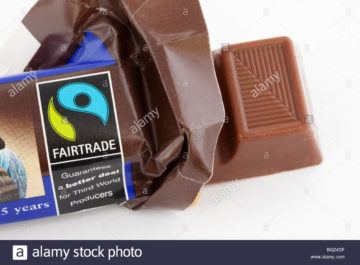
Another important label for chocolate is “Rainforest Alliance,” a certification that the farmer meets rigorous standards to grow sustainably, stop rainforest destruction, and help build economic opportunities for rural people. Rainforest Alliance does not go as far as Fair Trade to ensure that farmers get paid a fair price. On the other hand, they do more to promote sustainable growth and resist rainforest deforestation.
Finding chocolate that is labelled Fair Trade or Rainforest Alliance is difficult. Your best bet are specialty food stores, health food stores, or online. For example, Hershey claims that as of January 2020 they have achieved 100% certified and sustainable cocoa, sourcing through Fair Trade or Rainforest Alliance; however. However, I have found few of their products that carry this label. The same is true for other common brands of chocolate. \
If you were to visit a Mayan farm in the equatorial rainforests of South America 500 years ago, you would find cacao trees growing under the shade of taller rainforest trees, while the farmer and his family collected the pods, removed the seeds and dried the beans in the sun. The beans would be sold in local markets locally, or to traders. The Aztecs were a major market for the beans. They would grind the beans and use the paste to make a their “xocoatl”, meaning “bitter water.” An Aztec warrior would offer you a cup or two, which you would find stimulating and exhilarating, and perhaps make you feel bloodthirsty enough to go into battle.
If you want to have this experience as Hernan Cortes did in the 1500’s, make yourself a cup or two of Xocoatl using the following recipe.
Xocoatl
Ingredients
1 ½ cups water
1 green chile pepper, sliced
4 cups water
¼ cup unsweetened cocoa power
2 teaspoons vanilla extract
Directions
Bring 1 ½ cups of water to a boil in a pot; add the chili pepper and its seeds and boil for 5 – 10 minutes. Strain the chile from the water and return to the pot. Add the remaining 4 cups of water to the pot, reduce heat to medium low and bring to a slow boil. Slowly stir in the cocoa powder, bring to the boil and add vanilla extract. Cook until the powder is completely dissolved, about 5 to 10 minutes. Chill the drink and serve. Serves two—or one bloodthirsty warrior.
But fair warning – this is not for the faint hearted.
